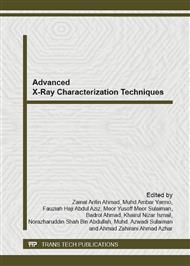p.198
p.203
p.208
p.213
p.219
p.224
p.230
p.236
p.241
The Effect of MgO Dopant on the Dielectric Properties of CaCu3Ti4O12 Ceramics
Abstract:
The properties of undoped and Mg-doped CaCu3Ti4O12 (CCTO) ceramics have been studied. The samples were calcined at 900°C for 12 hours, and sintered at 1030°C for 10 hours. X-ray diffraction analysis on calcined samples shown the formation of CCTO phase with trace of secondary phases meanwhile completed formation of CCTO single phase obtained for sintered pellets. The peak positions of Mg-doped CCTO were slightly left-shifted from the undoped CCTO, attributed to the lattice expansion. Scanning electron microscopy analysis showed that the grains size becomes larger with the increment of dopant amount. Enhanced dielectric constant was observed in the Ca1-xMgxCu3Ti4O12 ceramics with x = 0.05 for the frequency range from 1 MHz to 1 GHz. The dielectric loss seem to be at lowest value when Ca1-xMgxCu3Ti4O12 ceramics with x = 0.10 at the same frequency range. The results indicate that Mg ions have effectively changed the properties of CCTO.
Info:
Periodical:
Pages:
219-223
Citation:
Online since:
December 2012
Price:
Сopyright:
© 2013 Trans Tech Publications Ltd. All Rights Reserved
Share:
Citation:


